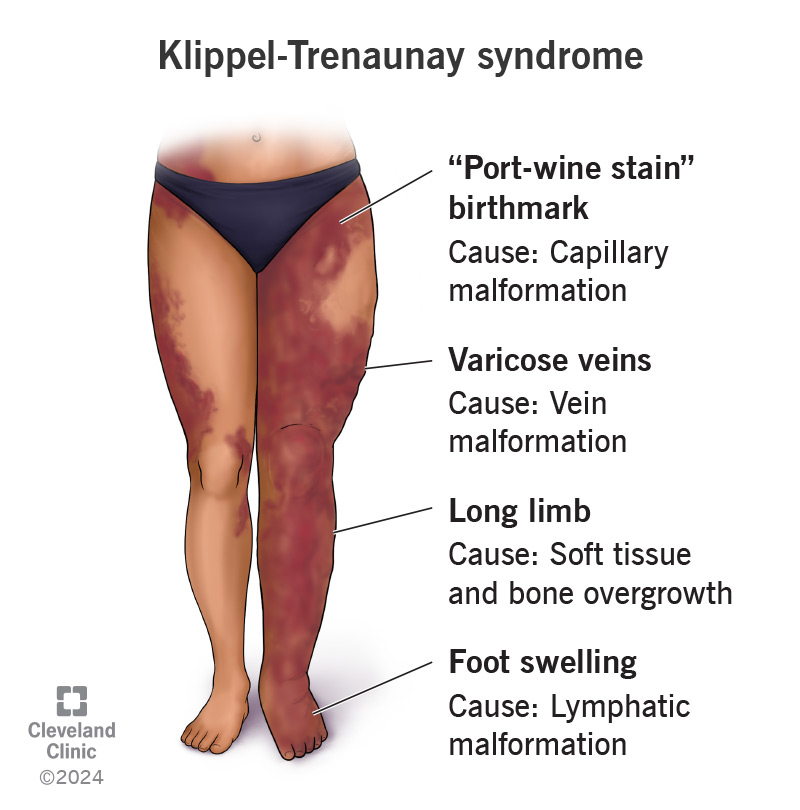Klippel-Trenaunay syndrome (KTS) is a rare congenital (present at birth) condition. It causes a port-wine stain birthmark, varicose veins and extra growth in one or more limbs. Treatments for this genetic issue range from medicines to surgery. With treatment, most people with KTS can live a typical life.
Advertisement
Cleveland Clinic is a non-profit academic medical center. Advertising on our site helps support our mission. We do not endorse non-Cleveland Clinic products or services. Policy

Klippel-Trenaunay syndrome (KTS) is a rare congenital (present at birth) disorder that causes a red “port-wine stain” birthmark, varicose veins and extra growth in one arm or leg. Many people also have issues in their lymphatic system, which helps maintain fluid balance in your body.
Advertisement
Cleveland Clinic is a non-profit academic medical center. Advertising on our site helps support our mission. We do not endorse non-Cleveland Clinic products or services. Policy
Some providers use the abbreviation CLVM for Klippel-Trenaunay syndrome. CLVM refers to the changes in your:
The M is for malformation, meaning a part of your body that didn’t develop in a typical way.
Various treatments, like medicine or laser therapy, can help you manage symptoms of this condition. Early diagnosis and treatment (often, soon after birth) can reduce the risk of complications.
KTS gets its name from the two French doctors who discovered it, Maurice Klippel and Paul Trenaunay. They identified the syndrome in 1900. Experts estimate that KTS affects about 1 in 100,000 people around the world. Anyone can get it; race or sex doesn’t matter.
Klippel-Trenaunay syndrome symptoms affect your veins, capillaries, soft tissues, bones and lymph vessels in these ways:
Advertisement
A variation in the PIK3CA gene often causes KTS. The gene variation occurs sporadically (for no known reason). You don’t inherit it from your parents.
Some people have KTS without having the PIK3CA variation. Because of this, researchers think other genetic variations could also cause KTS.
KTS may cause complications like:
Rarely, people with KTS also have congenital hand differences or toe differences, like:
Healthcare providers initially diagnose KTS based on the physical signs. You may get a KTS diagnosis if you have issues in two of these three areas: capillaries, veins or limbs.
Because many KTS symptoms are present at birth, your baby may receive a diagnosis before leaving the hospital.
Tests for Klippel-Trenaunay syndrome may include:
Klippel-Trenaunay syndrome treatment varies based on symptoms. Treatment may include:
Advertisement
See your provider for regular check-ups throughout your life. They can monitor your condition and treat any issues you have. Regular visits let your provider see how well treatments are working for you. They can make changes to your treatment plan along the way.
You need to go to the emergency room if you have a blood clot (leg pain, swelling and redness) or heavy bleeding. Blood clots include deep vein thrombosis and pulmonary embolism.
If you have KTS, you may want to ask your provider:
There’s no cure for Klippel-Trenaunay syndrome, but treatment can help you manage symptoms.
KTS itself doesn’t affect life expectancy. But some complications, like internal bleeding or pulmonary embolism, can be life-threatening. You need quick treatment for GI bleeding or blood clots in your deep veins or lungs. Blood clots or severe blood loss can be fatal. Getting ongoing treatment for these risks can reduce the danger of complications.
Most people with this syndrome have a good prognosis, but that can vary. It depends on how severe your vascular malformations are. They tend to get worse over time.
Advertisement
If you have Klippel-Trenaunay syndrome, taking good care of your skin can help prevent infections. You can lower your risk of blood clots in these ways:
Because KTS happens unpredictably, there’s no way to prevent it. But treatment can help people with KTS live a higher quality of life.
If you have Klippel-Trenaunay syndrome, you should:
See your provider for regular checkups throughout your life. They can monitor your condition and treat any issues you have. Regular visits let your provider see how well treatments are working for you. They can make changes to your treatment plan along the way.
You need to go to the emergency room if you have a blood clot or heavy bleeding. Blood clots include deep vein thrombosis and pulmonary embolism.
Advertisement
If you or your child has KTS, you may want to ask your provider:
KTS itself doesn’t affect life expectancy. But some KTS complications, like internal bleeding or pulmonary embolism, can be life-threatening. Getting ongoing treatment for these risks can reduce the danger of complications.
It can be. If KTS complications, like deep vein thrombosis or pulmonary embolism, prevent you from working, you may qualify for disability benefits. For other issues, like trouble walking due to limb growth, you may be eligible for accommodations, like a disability parking tag, to make your life a little easier.
It can be overwhelming to get a handle on all the symptoms and possible complications of Klippel-Trenaunay syndrome (KTS). Your provider can help you sort it out and focus on treating the issues you have. Don’t be afraid to keep them updated on how you’re feeling. Keeping lines of communication open will make it easier for you to reach out when you’re having an issue and need some advice.
Vascular disease may affect your life in big and small ways. Cleveland Clinic’s specialists treat the many types of vascular disease so you can focus on living.

Last reviewed on 11/06/2025.
Learn more about the Health Library and our editorial process.